The Show must go on
2000 Festival of Speed continues despite tragedy
Authors
- Mattijs Diepraam (words), Jeroen Bruintjes (photography)
Date
- 8W Special, July 26, 2000
Related articles
- Goodwood - A feast for the automotive senses, 1999 Festival of Speed report, by Mattijs Diepraam/Frank van de Velde
- Goodwood - Fried clutch and cooked pistons, served on a bed of smoked tyres, 2002 Festival of Speed report, by Mattijs Diepraam
- Goodwood - Demons and doughnuts, 2004 Festival of Speed report, by Mattijs Diepraam
- Goodwood - Yet more variety, 2005 Festival of Speed report, by Mattijs Diepraam/Maarten Hoeben/Peter Tunissen
- Goodwood - The coolest Earl on Earth, 2009 Festival of Speed report, by Jeroen Bruintjes
Who?Dick Attwood What?John Wyer Porsche 917K Where?Goodwood When?2000 Festival Of Speed |
 |
Why?
Called the best looking sportscar ever, the landmark Porsche 917 was a winner too, in whichever guise, however engined, in whatever sportscar series it competed in. In its most glorious World Sports Car and Can-Am forms, it was probably also the most powerful car ever to be handled compared to the quality of rubber that was available in those days.
Sure, it was bigger, better and flashier than last year's edition. The connoisseurs were treated to the mouthwatering sight of even more classic designs from a century of motorsport. The roaring sound of racing engines left some crying with joy. But then tragedy struck. 8W chief editor Mattijs Diepraam and photographer Jeroen Bruintjes report.
So far, each Festival of Speed delivered on its promise to better the previous one. In its seven years of existence the historic racing event has become a classic and was bound to outgrow its cult following soon after the details of the latest edition were announced. More contemporary F1 machinery than ever, a big Jaguar showcase, a soapbox spectacle and Jenson Button signing autographs: the organizers had spared no trouble in reaching a wider audience. With several timed runs boarding on the verge of insanity and F1 cars doing silly stuff along the one-mile hillclimb stretch, this year's event had a distinctly different feel than the previous. The atmosphere showed all the signs of an overly competitive and showy attitude among several entrants. The feeling was translated into tragedy. 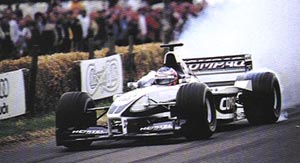 On Saturday afternoon, at around 4pm, John Dawson-Damer's four-wheel drive Lotus 63 suddenly veered off the finish straight, demolishing the timing gantry, in the process taking two marshalls with him. The 59-year-old Australian driver was killed, as was one marshall. The other marshall lost the bottom part of one leg and is still in hospital.
On Saturday afternoon, at around 4pm, John Dawson-Damer's four-wheel drive Lotus 63 suddenly veered off the finish straight, demolishing the timing gantry, in the process taking two marshalls with him. The 59-year-old Australian driver was killed, as was one marshall. The other marshall lost the bottom part of one leg and is still in hospital.
The rest of the Saturday runs were cancelled, as the crowd was sent home unknowing of what had happened. On Ceefax (the BBC teletext service), at around 5pm, it was announced that one driver and a marshall had been killed and another seriously injured but that Sunday's events would go on as planned. And go on they did. With the consent of the families involved, the organizers decided to handle things like in the old days: brush away the remains and do as if it never happened. Some felt it was (and still is) the only right way to handle it, others thought it distasteful and misguided. Whichever way is right, there was some incongruity in making all sorts of announcements to the press while not informing the public attending the event. Of course, the organizers meant well and the prospect of sending home (and refunding!) tens of thousands spectators won't have sat well. On the other hand, these things happen and it would be hypocritical to believe that motorsport - even of the sort practised at the Festival - is no longer a dangerous activity. But for many young people, used to all the drama and ho-hum that went with Senna's death, the hard-line approach taken by Lord March cum suis must have felt like an unnecessary turn back in time.
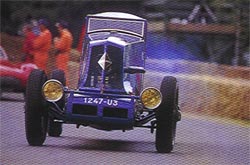 On Friday, Enthusiasts Day, there was none of the raunchy atmosphere some detected during the course of Saturday. This was the laid-back first day of the event, the day the entrants use to arrive at the Goodwood estate, fire up the engine for the first time to get the cobwebs out, and go for a first practice run. Especially the really old cars were looking splendid as they were wheeled into the Brooklands paddock. Unsurprisingly, most attention was devoted to Tim Birkin's Blower Bentley and the rival Mercedes SSK sportscar, Caracciola's supercharged white whale that Birkin tempted into breaking at the 1930 Le Mans 24hrs. On the other end of the paddock the ERAs D- and E-type were crowd pullers as well, their raw engine noise a far cry from that of the modern high-revving F1 powerplants. Particularly interesting were two of the first ever Renaults, Marcel's 1902 Paris-Vienna winner - a recreation of the famous Type K - looking especially smart. On the other side of the scale was the tank-like 40cv from 1926 which once was good for taking the world speed record from Bentley. Another recreation of the real thing, it now looked sizeable and heavy. It is hard to imagine this 9-litre contraption reaching 180mph in its quest for world glory.
On Friday, Enthusiasts Day, there was none of the raunchy atmosphere some detected during the course of Saturday. This was the laid-back first day of the event, the day the entrants use to arrive at the Goodwood estate, fire up the engine for the first time to get the cobwebs out, and go for a first practice run. Especially the really old cars were looking splendid as they were wheeled into the Brooklands paddock. Unsurprisingly, most attention was devoted to Tim Birkin's Blower Bentley and the rival Mercedes SSK sportscar, Caracciola's supercharged white whale that Birkin tempted into breaking at the 1930 Le Mans 24hrs. On the other end of the paddock the ERAs D- and E-type were crowd pullers as well, their raw engine noise a far cry from that of the modern high-revving F1 powerplants. Particularly interesting were two of the first ever Renaults, Marcel's 1902 Paris-Vienna winner - a recreation of the famous Type K - looking especially smart. On the other side of the scale was the tank-like 40cv from 1926 which once was good for taking the world speed record from Bentley. Another recreation of the real thing, it now looked sizeable and heavy. It is hard to imagine this 9-litre contraption reaching 180mph in its quest for world glory.
 Over from the Brooklands Museum came the two most famous Napier cars, Selwyn Edge's 40hp 1902 Gordon Bennett Trophy winner and of course John Cobb's stunning 24-litre (!) Napier-Railton, today still looking very much the part. In its glowy silver attire the beast stormed to the Brooklands Outer Circuit lap record it today still holds at 143.33mph and ran to some 40 other world records. Next to it stood Birkin's Blower Bentley monoposto, which held the Brooklands lap record (at 137.9mph, reached in 1931) before the Napier-Railton crushed it in 1933. The SF Edge Napier wasn't the only Gordon Bennett around, though.
Over from the Brooklands Museum came the two most famous Napier cars, Selwyn Edge's 40hp 1902 Gordon Bennett Trophy winner and of course John Cobb's stunning 24-litre (!) Napier-Railton, today still looking very much the part. In its glowy silver attire the beast stormed to the Brooklands Outer Circuit lap record it today still holds at 143.33mph and ran to some 40 other world records. Next to it stood Birkin's Blower Bentley monoposto, which held the Brooklands lap record (at 137.9mph, reached in 1931) before the Napier-Railton crushed it in 1933. The SF Edge Napier wasn't the only Gordon Bennett around, though. 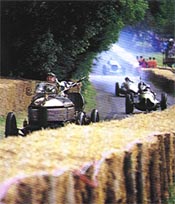 With it were the champion and challenger from the 1903 Isle of Man edition, taken by Mercedes and its 60 model, beating a fleet of three Napier 45hps. Napier's 1904 Gordon Bennett car was also present, brought to the Festival by Dutch Toyota importer Evert Louwman, who also drove it up the hill, the car waving a Dutch flag from the driver's seat. Back then, the car never reached the final, as Mark Mayhew crashed the car during the qualifying event on Man. Finally, we had the absolutely glorious recreation (but with the original engine installed) of Napier's 'Samson' car that Edge used to take one of the world's first land speed.
With it were the champion and challenger from the 1903 Isle of Man edition, taken by Mercedes and its 60 model, beating a fleet of three Napier 45hps. Napier's 1904 Gordon Bennett car was also present, brought to the Festival by Dutch Toyota importer Evert Louwman, who also drove it up the hill, the car waving a Dutch flag from the driver's seat. Back then, the car never reached the final, as Mark Mayhew crashed the car during the qualifying event on Man. Finally, we had the absolutely glorious recreation (but with the original engine installed) of Napier's 'Samson' car that Edge used to take one of the world's first land speed.
Other personal favourites in the Brooklands paddock were the famous Delage GP car that completely dominated the 1927 season with Robert Benoist, the 1914 Sunbeam Indycar, and the huge Fiat Grand Prix S74 from 1911, a monstrous chain-drive machine with a massive 14.2-litre engine towering above the driver's seat. Obviously, this was a car from the days the bore was limited, pushing manufacturers to increase the engine stroke to ridiculous heights. With the driver obliged to lean over from the side to see where he's going, it's hard to imagine this Fiat taking the 1912 American GP with Bragg at the wheel. Opposed to the many recreations which were allowed to the Brooklands paddock for the first time, it was heartwarming to see an original Bugatti 35C among them. 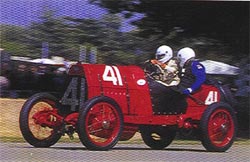 And by golly, was it original! Swiss owner Lukas Hühn had made no attempt at all to restore the ex-Trintignant car to its former glory, instead opting to leave the car in its race-battered 1926/'27 condition. This was how the ultimate customer racing car of the twenties looked like when driven in anger and since being put out of service it has remained so for nearly 75 years. It was only fitting that the Bugatti was to end up as class winner with a 70.55 ascent, beating George Wingard's 14-litre Fiat GP car.
And by golly, was it original! Swiss owner Lukas Hühn had made no attempt at all to restore the ex-Trintignant car to its former glory, instead opting to leave the car in its race-battered 1926/'27 condition. This was how the ultimate customer racing car of the twenties looked like when driven in anger and since being put out of service it has remained so for nearly 75 years. It was only fitting that the Bugatti was to end up as class winner with a 70.55 ascent, beating George Wingard's 14-litre Fiat GP car.
The thirties collection was pretty interesting as well. Leading the entry were the two classic Alfa race cars of the early thirties, the Tipo B and the Monza. The Monza's counterpart from its duel in the 1933 Monaco GP, the Bugatti T51, Nuvolari beating Varzi after a race-long duel, was parked next to it. More interesting was Bugatti's T53, one of the world's first ready-to-use permanent four-wheel drive machines, the car putting all its 325bhp to good use in hillclimb classics such as the one at the Klausenpass. Among its drivers are such names as Wimille, Chiron and Dreyfus. Best of looking of the bunch, but out of place at the Mercedes area in the post-war paddock, was the unique Mercedes W165 voiturette, especially built for the 1939 Tripoli race. Driven by John Surtees all weekend, the car still looked as much a winner as the other famous purpose-built Mercedes machine, the Penske Indycar with 6-litre Mercedes pushrod engine that visited the event last year.
 As the pre-war cars got underway for their afternoon runs, the loud Jaguar display in front of the Goodwood House suddenly became alive with the noise of a Broadspeed Jaguar XJ5.3C. This was a welcome diversion from the rather silly "Cat's Cradle" centre showpiece, which had several classic Jaguar cars hanging in the air, their bottoms facing the sky. Opposite was a mock-up of the Jaguar R1 Grand Prix car, also hoisted up but with its nose pointing to the ground. It was a graphic image for the way the F1 team is going right now. Compared with last year's classy Audi display, this was all pretty tacky and it showed that Jaguar is now merely a Ford marketeer plaything, relaunched with typical Motown brash rather than English refinement and good taste.
As the pre-war cars got underway for their afternoon runs, the loud Jaguar display in front of the Goodwood House suddenly became alive with the noise of a Broadspeed Jaguar XJ5.3C. This was a welcome diversion from the rather silly "Cat's Cradle" centre showpiece, which had several classic Jaguar cars hanging in the air, their bottoms facing the sky. Opposite was a mock-up of the Jaguar R1 Grand Prix car, also hoisted up but with its nose pointing to the ground. It was a graphic image for the way the F1 team is going right now. Compared with last year's classy Audi display, this was all pretty tacky and it showed that Jaguar is now merely a Ford marketeer plaything, relaunched with typical Motown brash rather than English refinement and good taste.
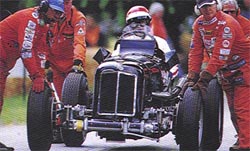 The Grand Prix cars on the track brought more joy as Ludovic Lindsay set the ball rolling with a terrific 62.5s in ERA R4D. His class rival Duncan Ricketts, driving the wonderful ERA R1E, immediately topped that with 61.2. Meanwhile, one of the best sounding engines in the business was given its first go, the 5-litre Chevy block in the back of a Lotus 70 F5000 car fired up using litres of Castrol R.
The Grand Prix cars on the track brought more joy as Ludovic Lindsay set the ball rolling with a terrific 62.5s in ERA R4D. His class rival Duncan Ricketts, driving the wonderful ERA R1E, immediately topped that with 61.2. Meanwhile, one of the best sounding engines in the business was given its first go, the 5-litre Chevy block in the back of a Lotus 70 F5000 car fired up using litres of Castrol R.  Driver Richard Drewitt then brought it out to lower the best time to 59.7s before fellow sixties F1 afficionados Ben Liebert and the tragic Hon John Dawson-Damer posted even better times (57.1s and 56.5s) in their Eagle T1G and Lotus 63. The early 3-litre F1 cars certainly belonged to the best-looking and best-conserved part of the paddock, its torquey engines having no trouble in attacking the hill.
Driver Richard Drewitt then brought it out to lower the best time to 59.7s before fellow sixties F1 afficionados Ben Liebert and the tragic Hon John Dawson-Damer posted even better times (57.1s and 56.5s) in their Eagle T1G and Lotus 63. The early 3-litre F1 cars certainly belonged to the best-looking and best-conserved part of the paddock, its torquey engines having no trouble in attacking the hill.
Another one in combat mode, meanwhile, was one of last year's stars, Peter Hardman repeating his usual slip-and-slide stuff with the Aston Martin DBR1. With 58.8s, he was comfortably quickest of the period sportscars he was fighting, although the Maserati Birdcage also looked agile up the hill. In the paddock, Peter unashamedly offered his services as a racing driver by handing out brochures and pointing everyone interested to his web site. Given the fact his balls-out drives were the best advertisement one could wish, he was generally forgiven for his commercial approach…
Best entertainment value for all three days, however, came from Thoroughbred GP championship leader Martin Stretton. In the car that turned me into a motorsports fan in the first place, Martin was the man to beat for the whole of the weekend. It would even have been a greater sight to see him race the original P34 of 1976, the blue-and-yellow sleek version driven by Jody Scheckter and Patrick Depailler. But then his bulkier First National City Bank-sponsored 1977 version was the ex-Ronnie Peterson car, so that evened it out a bit. Sneaking in a second Friday run, Stretton was in Super Swede mode from the start and paid hommage to its original driver by manhandling the machine through corners like it was a rally car. Mind you, with Goodyear stopping its rubber development for the little front tyres back in 1977, that was exactly the way I remember Ronnie slinging it around. 23 years ago, the car was a handful (which needed a man like Ronnie to drive his way around the problem) but this time it looked like Stretton could do whichever he pleased with it. His first tip-toe run on Friday already brought a 49.5s, while the second was finished in a magnificent 47.8s, topping the finish straight speeds with 132mph. In contrast, the other top drivers of the day - Drewitt, Lindsay, Hardman - could only manage 110mph.
Still Stretton's time was way off Nick Heidfeld's hill record of 41.6s, set last year. In terms of technology, however, Heidfeld's 1998 McLaren is light years ahead of the P34, so Stretton's performance should not be underestimated. On Saturday, with his second run cancelled after Dawson-Damer's death, he took off another second to record a 46.67s, while on Sunday he used his runs to pull off 1.5s to nail the Best Time Of The Day for good with 45.05s. Amazingly, his finish straight speed had been 148mph. With that, he narrowly beat Jonathan Palmer's former 1997 hill record, but that was set in a 1996 McLaren-Mercedes, which pretty much shows the extent of Martin's speed. One can only guess what guest star Alan Jones, reunited with his championship-winning ground-effect Williams FW07B, would have done if he hadn't been on just a demo run.
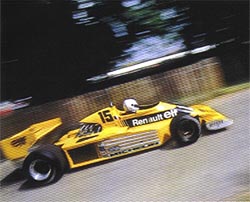 Opposed to the DFV-powered seventies cars, the F1 turbo cars of the eighties were struggling to find speed. Their enormous turbo lag not particularly helping them on the first-gear, second-gear course, the cars looked frightfully out of place. It didn't help that some of the cars were driven by mere enthusiasts, such as Peter Ratcliffe at the wheel of the ex-Senna Lotus-Renault 98T, but then René Arnoux was nursing a constant misfire in the original Renault turbo car, with Jean Ragnotti trying to overcome the same problem in his 1984 Renault RE50. It just seems these engines are much harder to prepare and keep in shape with little effort than the simple atmospheric Ford Cosworths.
Opposed to the DFV-powered seventies cars, the F1 turbo cars of the eighties were struggling to find speed. Their enormous turbo lag not particularly helping them on the first-gear, second-gear course, the cars looked frightfully out of place. It didn't help that some of the cars were driven by mere enthusiasts, such as Peter Ratcliffe at the wheel of the ex-Senna Lotus-Renault 98T, but then René Arnoux was nursing a constant misfire in the original Renault turbo car, with Jean Ragnotti trying to overcome the same problem in his 1984 Renault RE50. It just seems these engines are much harder to prepare and keep in shape with little effort than the simple atmospheric Ford Cosworths.
Although we had four full-blown comtemporary F1 entries present, none of them eventually represented a danger to Heidfeld's time. To some it was a disappointment that none of these cars was put to the test and were merely there to increase the show. On the other hand that show was tremendous and it allowed the audience to see what drivers are forbidden to do at regular Grand Prix weekends: make practice starts with excessive wheel-spin, do dozens of doughnuts, over-rev the engine while letting its high-pitched scream gallop across the entire estate. Oh, and slam the car into the barriers. At least that's what parting Jordan designer Mike Gascoyne did with his Fortec-run Jordan 199, the overzealous amateur racer seriously overcooking it on his final Sunday run, despite all the BOSS experience he could throw at the beast.
This year, McLaren had failed to secure Heidfeld's services, the young German not allowed a weekend away by his Prost sponsors. Instead, they fielded a rather less serious effort, the driving spoils shared between McLaren two-seater regular Darren Turner and ITV co-commentator Martin Brundle. On Friday, Turner gave it some stick but contrary to what the programme said, his effort wasn't timed. On the other days, ex-GP driver Brundle followed the Herbert/Button gang who chose to turn their demonstration runs into a rubber and clutch-demolishing contest. Taking into account that the large part of JH's Sunday demos was clouded in smoke, birthday boy Johnny probably won.  It left everyone wondering whether Herbert used the Festival as a legal excuse to give a serious Basil Fawlty-style thrashing to the car he has come to hate over the first half of this season. To the outsider at least, it looked like there was a lot of resentment in the way Johnny tortured the R1 mechanicals…
It left everyone wondering whether Herbert used the Festival as a legal excuse to give a serious Basil Fawlty-style thrashing to the car he has come to hate over the first half of this season. To the outsider at least, it looked like there was a lot of resentment in the way Johnny tortured the R1 mechanicals…
As said, there was a strangely competitive atmosphere hanging in the air on Saturday. The regulars of the fast runners, which had formed itself on Friday, were at it again the day after, Lindsay posting a 60.80s, before Hardman set a 57.15s, beaten by Richard Drewitt with a 57.08s. Then Dawson-Damer did a serious run with a 55.08s - his 4WD Lotus obviously suited to the hillclimb - before last year's Glover Trophy winner at the Revival Meeting, Geoff Farmer, joined the speed freaks, using Seppi's Rob Walker Lotus 49 to post a 54.80s.
Farmer was also the last one across the line before Dawson-Damer started on his fatal second run. The ex-Andretti Lotus 63, one of two remaining monocoques, had been a force to be reckoned with all weekend at the hands of the experienced Lotus restorer. In 1969, the experimental 4WD F1 season par excellence, the car had been hated by Rindt and Hill, and so Colin Chapman entrusted the machine to third driver John Miles. At the 'Ring, Mario Andretti was given the car, and he duly destroyed it in a fierce practice crash. Three decades ago, its driver walked from the scene, which wasn't always the case with shunts at the notorious Eifel track. Now, on a revival event, with trees lining the track unprotected, as used to be the case at the 'Ring, the results were infinitely more tragic. The verdict is still out on what happened. Fact is the car suddenly swerved to the left while being on a straight line, which could point to a mechanical failure (the car does have a history in breaking) or DD's heart condition playing tricks at the most dramatic of moments. Whatever the case, it was a heartsinking moment for everyone coming home early to find on Ceefax that indeed the accident that caused the cancellation had claimed two lives.
At the time Dawson-Damer was killed, the event had already been running late. This was due to the inaugural Soapbox Challenge involving driveless karts steered downhill by several celebrities of sort, including Stirling Moss and the witty Alain de Cadenet, who entertained all with an extremely funny exposé on the design of his Williams-penned and run soapbox. With the first run finally underway it ran into a mess practically at once, with one driver going off at Molecomb, the tight corner at the bottom of the hill. At that point, the boxes were running at speeds over 50mph, so it was logical some of them would topple their vehicles while steering into this bend too violently. The second run was halted due to the crash, while the third was an exact copy of the first one, again one of the soapboxes heading into the strawbales at Molecomb. It was a strange sensation that no-one had seen this coming or that the downhill run was apparently not tested before. With the second casualty sufficiently hurt, this was the first time that day an ambulance was driving across the track. It meant a spooky foreboding of the horrible events to come, just minutes after the usual uphill antics had restarted.
On Sunday, we had less cars going for a time, although the usual bunch of fast men profited from the upturn in the weather to smash their Saturday times. Getting into a groove was Richard Attwood in one of the Porsche 917K (for Kurzheck, short tail) cars present. Copying his 1999 form Dickie was slow on Friday and Saturday but literally managed to get his tail out on Sunday, sizzling to a magnificent 56s flat. Which was more than could be said of the rival sports monsters from the early seventies. Still looking their absolute best, the two Modena Motorsport-run Ferraris present (a 512S and a 312 Prototipo Boxer) were cruising to the top, while the once all-conquering Alfa T33 crept its way up, plagued by a continuing misfire. The ex-Donohue Porsche-Audi 917-10 Can-Am derivative, probably the most powerful sportscar ever, was another car gently chauffeured up the hill, in stark contrast to its thundering form from the past. But at least it wasn't on static display like the Audi R8 that had just returned from winning the Le Mans 24 hours. Sadly, the Audi Sport people had taken the Tony Southgate-penned and Dallara-constructed machine to the cleaner's, allowing us to think this could well have been a mock-up instead of the real thing. No such frivolity with the class-winning ORECA Viper of Messrs Beretta, Wendlinger and Dupuy, which was still covered with dirt and rubber. And it drove.
Furthermore, today finally someone who knew how to punch the thing was at the wheel of the awesome Audi S1 Quattro E2. Awesome-looking? Well, no. Awful would be closer. But totally built to practicality and purpose, an awesome driving experience it must have been. The short-wheelbased, turbo-powered Group B car dodged left and right, wanting to go anywhere but in a straight line, its wastegate whistling with every gear change - the sound that made you distinguish an Audi from all other cars. Between the whistles, the engine was surprisingly silent, but that is a common treat found in blown engines. Then again, the quattro's relative silence was nothing compared to that of the Mercedes S-class used by the Clark of the Course, which comparatively eased by after every batch of runs as if it had no engine at all. What a difference a racing exhaust system and an open engine bay make. Its close relative, the street-legal version of the CLK-GTR GT1 car, also oozed engine refinement, the silvery machine putting its horsepower to use in the most unobtrusive of ways.
 Which can't be said for the seventies touring cars which had their own private battle for three days. The outcome was the same as back then, the BMW 3.0 CSL 'Batmobiles' consummately outclassing the bulky Broadspeed Jaguar XJ5.3C that was present. As expected, with 53.5s Geoff Farmer's Lotus 49 was comfortably fastest of the late-sixties F1 bunch - then as now - (although Jackie Oliver's bewinged McLaren M7C looked smarter) while Richard Drewitt took F5000 honours with an eventual 55.01s. Farmer's time meant being third fastest of the weekend, while Drewitt's Lotus 70 was fourth, just ahead of the ill-fated Lotus 63 of John Dawson-Damer (55.08s). Attwood's time was sixth best.
Which can't be said for the seventies touring cars which had their own private battle for three days. The outcome was the same as back then, the BMW 3.0 CSL 'Batmobiles' consummately outclassing the bulky Broadspeed Jaguar XJ5.3C that was present. As expected, with 53.5s Geoff Farmer's Lotus 49 was comfortably fastest of the late-sixties F1 bunch - then as now - (although Jackie Oliver's bewinged McLaren M7C looked smarter) while Richard Drewitt took F5000 honours with an eventual 55.01s. Farmer's time meant being third fastest of the weekend, while Drewitt's Lotus 70 was fourth, just ahead of the ill-fated Lotus 63 of John Dawson-Damer (55.08s). Attwood's time was sixth best.
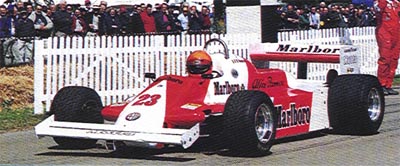 Some other rivalries went the other way, however. What about the prizeless Maserati 250F streamliner, the Lancia D50 reinvention and the 250F-based Tecnica Meccanica 415F? Back in the mid-fifties anyone would have bet on this front-engined GP machinery to finish in the order I just mentioned. Well, it was the other way around. Back then the Tec-Mec was no more than the latest (and late) introduction of an outdated design (see Don Capps' Maserati 250F special), at the Festival the 415F looked agile and feisty, in the end recording a creditable 61.03s, just edging out Willie Green's D50 with 61.52s. It's all a matter of maintenance, I guess. And of course experienced historic racer Barrie Williams handling the Tec-Mec would make a difference, yes. Similarly, the 1938 ERA E-type driven by Duncan Ricketts took unexpected class honours with a splendid 59.70s. According to Ricketts this was probably the first time R1E had won anything!
Some other rivalries went the other way, however. What about the prizeless Maserati 250F streamliner, the Lancia D50 reinvention and the 250F-based Tecnica Meccanica 415F? Back in the mid-fifties anyone would have bet on this front-engined GP machinery to finish in the order I just mentioned. Well, it was the other way around. Back then the Tec-Mec was no more than the latest (and late) introduction of an outdated design (see Don Capps' Maserati 250F special), at the Festival the 415F looked agile and feisty, in the end recording a creditable 61.03s, just edging out Willie Green's D50 with 61.52s. It's all a matter of maintenance, I guess. And of course experienced historic racer Barrie Williams handling the Tec-Mec would make a difference, yes. Similarly, the 1938 ERA E-type driven by Duncan Ricketts took unexpected class honours with a splendid 59.70s. According to Ricketts this was probably the first time R1E had won anything! 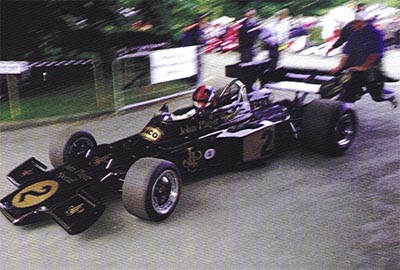 Of course, the same applied to Stretton's P34, although none of the class opposition - which also comprised Bruno Giacomelli in the Alfa 179 and Emerson Fittipaldi, reunited wth his Lotus 72D - gave it a serious try.
Of course, the same applied to Stretton's P34, although none of the class opposition - which also comprised Bruno Giacomelli in the Alfa 179 and Emerson Fittipaldi, reunited wth his Lotus 72D - gave it a serious try.
In the meantime, the spectators at Molecomb had first-class seats for several cars flying off, failing to negotiate the tight left-hander. In the morning Marc Surer in the purposeful March-BMW 792 which took him to European F2 title honours in 1979, slid off while oversteering heavily. Luckily, he didn't hit a thing, which was fortunate, since Marc was due to record second best time of the day with a 51.29s later in the afternoon. Worse off was Maserati Birdcage driver Tony Smith, who went straight on in an attempt to reclaim the best class time he just lost to the unstoppable Peter Hardman (with 56.66s). That morning had seen a valiant effort by Smith, setting a 57.1s and putting one over Hardman on a territory the Aston Martin driver must have thought his own. In the end Peter won by default, the Birdcage nose looking pretty dented once it was towed back to the paddock. Then, about an hour later, Johnny Dumfries ducked into the bales in similar style, The Earl grabbing his helmet in despair at the moment he climbed out. Perhaps he feared he would become this year's Jonathan Palmer - in 1999 the doctor embarrassingly clouted the prizeless ex-Senna MP4/5 into the barriers on his way to the start line, irreparably damaging the suspension - but the Le Mans-winning machine he co-drove with Jan Lammers (also present) and Andy Wallace seemed properly bolted together. Without any apparent damage the XJR9 was rolled backwards.
Then it was time to close off an eventful weekend with today's rally stars, Armin Schwarz in the Hyundai having the better of Peugeot's Marcus Grönholm in the entertainment stakes. Every 100ft, the German would violently throw his Accent into a drift, powersliding through every corner of the track. Grönholm was undoubtedly faster but Schwarz won the beauty contest. Unfortunately, all the modern cars went untimed, so we were not to know whether the 206 WRC had come near the time of Martin Stretton. Similarly, the drivers at the wheel of the four current F1 cars present abstained from taking a stab at Heidfeld's 1999 time. Instead, they took full opportunity to show off some of their other virtues. Indeed, the smell of burnt Bridgestone rubber was present for at least half an hour after Johnny Herbert had finally shut off the ignition of his R1. F1 tyres aren't even made of rubber anymore these days, you say? Point taken, but I sure appreciate the Japanese tyre company injecting a burnt-rubber smell into their compounds... 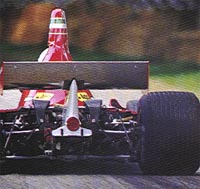 Equally, while the current F1 atmosphere might not be as cheerful, lighthearted and sporting as before, the out-of-this-world sound of a modern F1 engine is still an awesome spectacle for your eardrums. While you would hear the impressive clamor of Ernst Schuster's 1974 Ferrari 312B3 just before it took the corner before your vantage point, the current Mercedes, BMW and Cosworth engine sounds are so penetrating that you won't have any trouble hearing it turn up the revs from over a mile's distance. The technology has come a long way.
Equally, while the current F1 atmosphere might not be as cheerful, lighthearted and sporting as before, the out-of-this-world sound of a modern F1 engine is still an awesome spectacle for your eardrums. While you would hear the impressive clamor of Ernst Schuster's 1974 Ferrari 312B3 just before it took the corner before your vantage point, the current Mercedes, BMW and Cosworth engine sounds are so penetrating that you won't have any trouble hearing it turn up the revs from over a mile's distance. The technology has come a long way.
The following day, on our way back to the continent, we stopped over at the Brooklands site near Weybridge, in the South London area which was the birthplace of British motorsport and now has grown into the motorsport centre of the world. The Museum, with a huge open spot where the Napier-Railton should be, was very informing, especially with regards to the several track layouts that were used. But it was nothing compared to the real experience of walking on the actual banking. Sadly, only a small part has survived while the rest has been torn down to create space for a new office site and the airstrip which used to be on the infield. Still, in the half hour that we just walked back and forth across the ill-preserved concrete slabs creeping up towards the railway lining the track, silence only dispersed by the sound of birds, a passing train and our own voices, we felt more connected with history than we did all weekend.
Main pictures by Jeroen Bruintjes. Additional pictures from Autosport (LAT/Jeff Bloxham), Motorsport and Thoroughbred and Classic Cars. All copyrights are acknowledged.
